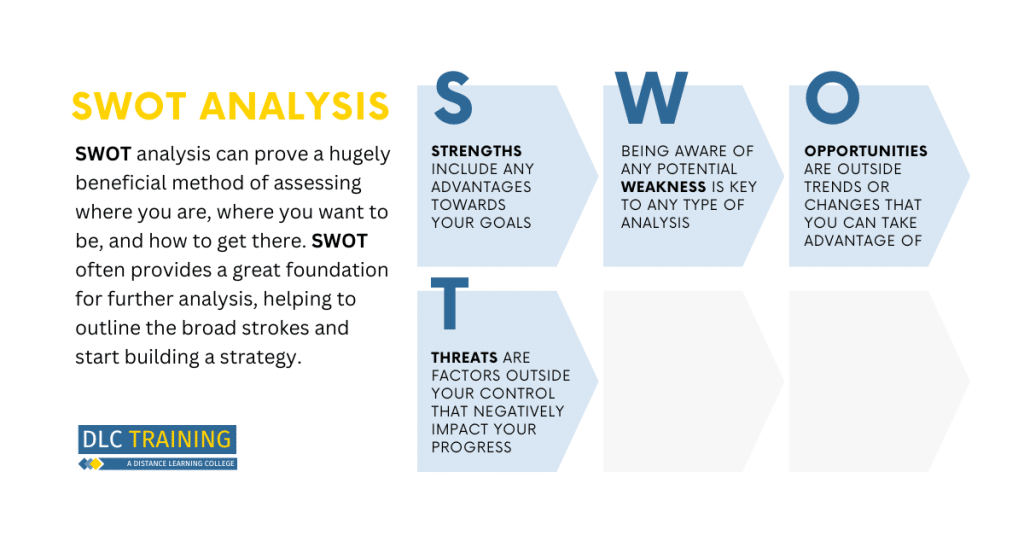Whether you’re looking at a specific project, an individual’s development, or an entire business, a great way to analyse and understand your position is by carrying out a SWOT analysis. This blog post will explain what a SWOT analysis is, how to use it, and provide examples of how it works in practice.

What is a SWOT Analysis?
A SWOT analysis is a valuable tool used to better understand a situation, project, business, or even personal goals. The name comes from the four key areas it looks at:
- Strengths
- Weaknesses
- Opportunities
- Threats
It helps you take a step back and look at both internal factors (like what you’re good at or where you need improvement) and external factors (like potential opportunities or challenges in your environment). Whether you’re making a big decision, planning for the future, or just trying to get a clearer picture of where you stand, a SWOT analysis is a great place to start.
S – Strengths
A SWOT analysis starts with your strengths. These are the things that give you an advantage or help you reach your goals, whether for a project or your professional development.
Let’s start by looking at an example of how SWOT analysis can be used for a new business idea. Your strengths for starting the business could be that you have a unique product that stands out in the market, a passionate and motivated team, early excitement or positive feedback from potential customers, and low start-up costs that make it easier to get off the ground.
Recognising these strengths early on can help you build confidence and focus your efforts where they’ll have the most impact.
Another example of using SWOT analysis is to look at an individual’s career development. In this case, strengths are the personal qualities and achievements that give someone an advantage in their job or industry. These might include years of experience, strong communication skills, and specialised qualifications or training.
Identifying these strengths can help a person understand what they bring to the table, build confidence, and make better decisions about their next career steps.
W – Weaknesses
A good analysis needs balance, which is why after identifying your strengths, the next step in a SWOT analysis is to look at your weaknesses. This involves being honest about any challenges, limitations, or areas where you may be at a disadvantage.
When applying SWOT analysis to a new business, weaknesses might include low brand recognition, limited publicity, or a small budget. These challenges can make it harder for the business to grow or compete early on.
For an individual’s development, weaknesses could be things like limited experience, a lack of specific skills, or missing qualifications. Understanding these areas gives a clearer picture of what needs improvement and helps you focus your efforts where they matter most.
O – Opportunities
The “O” in SWOT stands for opportunities. This is where the analysis shifts from looking at internal factors, like strengths and weaknesses, to external ones. Opportunities are the outside trends or changes that you can take advantage of to grow and improve.
For a new business, opportunities might include strong market demand, new trends, changes in laws or regulations, or emerging technology. These can create chances to do things differently or more efficiently, especially in ways that bigger, more established companies might overlook.
On a personal level, opportunities for career development could include attending networking events, taking part in training or courses, or strengthening professional relationships. Spotting and making the most of these chances can help you move forward faster and more confidently.
T – Threats
“T” in SWOT stands for threats. Similar to opportunities, this focuses on external factors, but this time, you’re looking at factors that could be potential challenges. These are the factors outside your control that could negatively impact your progress or success.
For a new business, threats might include strong competition from established brands, changes in laws or regulations, shifting customer preferences, or economic uncertainty. All of these can affect how well the business performs in the market.
When it comes to personal career development, threats could include things like company restructures, risk of redundancy, or tough competition for promotions. Being aware of these potential obstacles helps you prepare and adapt, so you’re not caught off guard.
Conclusion
A SWOT analysis is a simple yet powerful tool for gaining clarity on your current position, setting future goals, and mapping out the best path forward. By offering a clear structure, it helps you see the bigger picture and identify key areas to focus on.
What makes SWOT analysis especially useful is its ability to break things down into clear, easy-to-understand categories. It encourages you to think about both internal and external factors, helping you approach decisions with greater insight and confidence. It’s an adaptable tool that can be used for many different situations you come across, whether you’re launching a new business, planning a project, or working on personal development. Used thoughtfully, a SWOT analysis can be a fantastic starting point for smarter strategies and more successful outcomes.
Find more useful information and tools on our blog and resource pages.